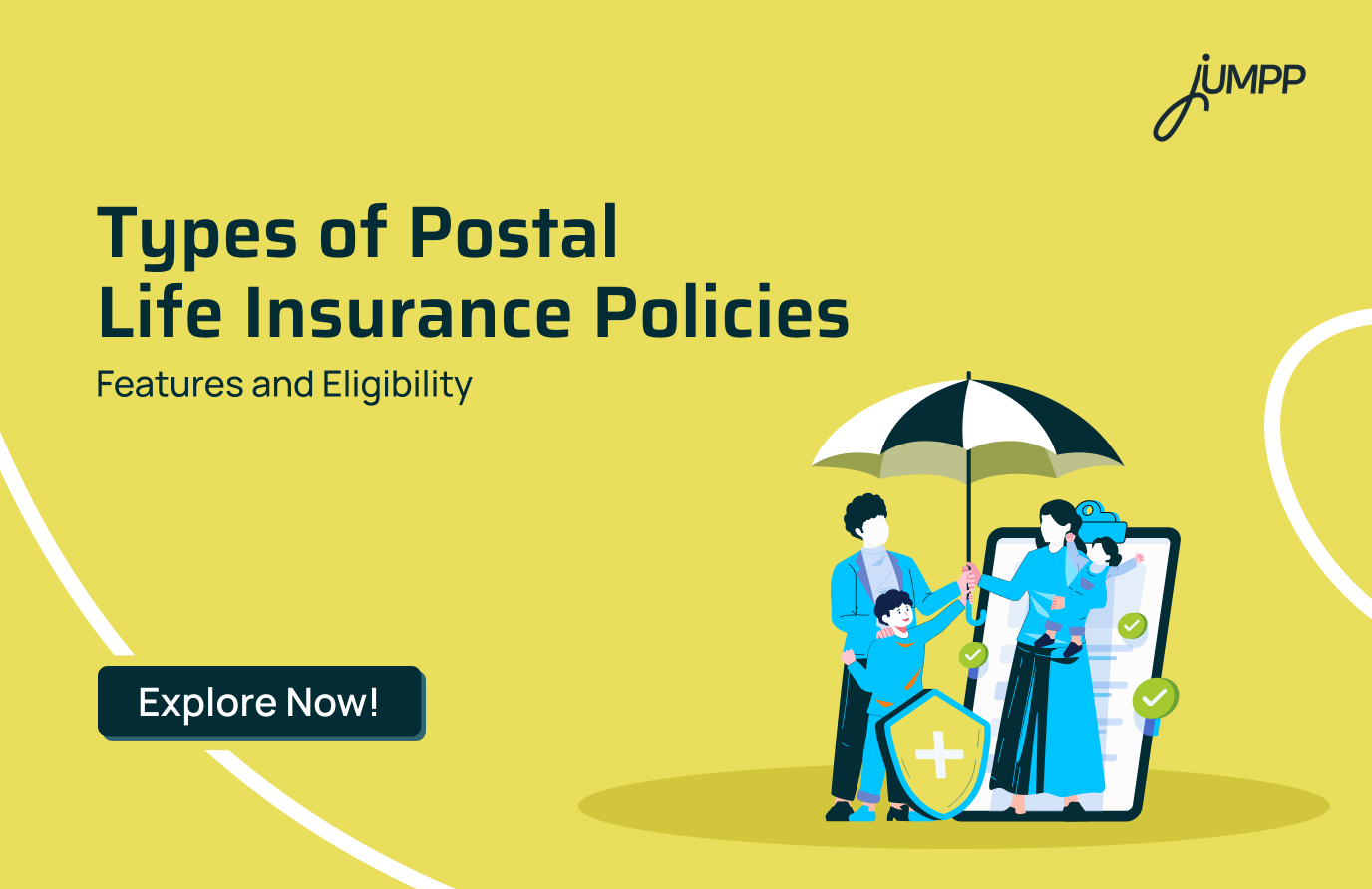What is the Postal Life Insurance Scheme? Benefits, Types & Details

We all know about popular post office savings schemes like POMIS, SCSS, and the regular post office savings account. But did you know about the PLI scheme? This is a postal life insurance scheme that has been protecting Indians for over 130 years.
PLI full form is Postal Life Insurance.
Long before private insurers existed, PLI was helping postal staff, government employees, and professionals secure their families’ future. Even today, it offers affordable premiums, attractive bonuses, and the trust that only a government-backed scheme can provide.
Let’s introduce you to postal life insurance benefits!
What is a Postal Life Insurance Scheme (PLI)?
Postal Life Insurance (PLI) is the oldest life insurance scheme in India, introduced on 1st February 1884. PLI is a government-sponsored scheme offering low-cost life insurance policies with high bonus amounts. Initially launched for Postal and Telegraph employees, it later became the first insurance scheme in India to extend coverage to women employees when private insurers did not.
By 1888, PLI was extended to employees of the Telegraph Department.
Later, in 1894, it became the first insurance scheme in India to cover female employees of the P&T Department. This happened at a time when no private insurer offered coverage for women.
Features of the Postal Life Insurance Scheme (PLI)
- It is backed by the Government of India, making it one of the safest insurance choices.
- PLI offers low premiums while giving comparatively higher returns.
- You get the tax benefits under Section 80C, and in some cases, under Section 10(10D).
- There are multiple types of PLIs
- You can also take a loan against the policy after a certain period.
- It also gives you the option to convert some policies into other plan types.
- The Postal Life Insurance plan also provides duplicate policy bonds in case the original is misplaced.
Eligibility for Postal Life Insurance
PLI is not open to the general public. It is designed for certain categories of employees and professionals.
The following are eligible for the post office insurance scheme:
- Central Government employees
- State Government employees
- Defence Services and Para-Military forces
- Employees of Local Bodies
- Employees of Government-aided Educational Institutions
- Staff of the Reserve Bank of India
- Employees of Public Sector Undertakings (PSUs)
- Employees of Nationalised Banks and other Financial Institutions
- Staff of Autonomous Bodies
- Extra Departmental Agents in the Department of Posts
- Contractual employees in the Central/State Government (if contract is extendable)
- Employees of scheduled Commercial Banks
- Members of registered Co-operative Societies, partly or fully funded by Government bodies
- Employees of Universities, accredited educational institutions, and private schools affiliated to recognised boards
- Professionals such as Doctors, Engineers, Chartered Accountants, Lawyers, Management Consultants, Architects, and Bankers
- Employees of listed companies on NSE and BSE in sectors like IT, Finance, Healthcare, Energy, and Telecom
How to Apply for Postal Life Insurance?
Here are the proper steps to apply for Postal Life Insurance (PLI) in India as of 2025:
- First, you can visit your nearest post office. Second, you can check the official India Post Postal Life Insurance customer portal online.
- Obtain and fill out the PLI application/proposal form
- Submit the completed form along with required documents such as identity proof, address proof, and passport-sized photographs.
- Pay the initial premium either at the post office counter or through online payment portals.
- After submission and payment, you will receive a Customer ID or policy document as confirmation.
- You need to ensure a nominee is registered on your policy for claim benefits.
- For verification, you may be required to visit the post office with your form and documents as part of the application processing.
This process ensures you are registered for Postal Life Insurance.
What are the Types of Postal Life Insurance Policies
There are six types of post office insurance schemes offered in India.
| PLI Scheme | Entry Age | Sum Assured | Bonus | Special Features |
| Whole Life Assurance (Suraksha) | 19–55 yrs | ₹20,000 – ₹50 lakh | ₹76 per ₹1000 per year | You can convert to an Endowment up to 59 years Premium paying age options: 55, 58, 60 years |
| Convertible Whole Life Assurance (Suvidha) | 19–50 yrs | ₹20,000 – ₹50 lakh | ₹76 per ₹1000 per year (if not converted) | You convert to Endowment after 5 years (before 6 years) |
| Endowment Assurance (Santosh) | 19–55 yrs | ₹20,000 – ₹50 lakh | As per the yearly declaration | Full sum assured + bonus paid to the nominee on death |
| Joint Life Assurance (Yugal Suraksha) | 21–45 yrs | ₹20,000 – ₹50 lakh | As per the yearly declaration | Elder spouse max 45 yrs; Policy term 5–20 yrs |
| Anticipated Endowment (Sumangal) | 19–40 yrs (20 yrs term) 19–45 yrs (15 yrs term) | Up to ₹50 lakh | ₹48 per ₹1000 per year | Survival payouts (20% + 20% + 20% + 40%) |
| Children Policy (Bal Jeevan Bima) | Child: 5–20 yrs; Parent: ≤45 yrs | Up to ₹3 lakh or equal to parents’ policy | As per the yearly declaration | Paid-up option after 5 years’ premium; Full sum assured + bonus on maturity |
| Rural Postal Life Insurance (RPLI) | 19–55 yrs | ₹10,000 – ₹10 lakh (varies by plan) | As per yearly declaration | Started in 1995 for rural people; Affordable insurance for weaker sections & women; Uses post office network; Lower premium rates than PLI |
1. Whole Life Assurance (Suraksha )
This post office insurance plan provides coverage until the insured reaches 80 years of age or in case of death, whichever comes first. At maturity, or to the nominee in case of death, the assured sum, along with bonuses, is paid.
- Eligibility: 19–55 years
- Sum Assured: ₹20,000 to ₹50 lakh
- Loan Facility: After 4 years
- Surrender: After 3 years
- Bonus: ₹85 per ₹1,000 sum assured per year
2. Endowment Assurance (Santosh)
This PLI plan gives the sum assured along with bonuses at maturity, which can be at ages 35, 40, 45, 50, 55, 58, or 60. If the insured passes away before maturity, the nominee receives the full sum assured plus the bonus.
- Eligibility: 19–55 years
- Sum Assured: ₹20,000 to ₹50 lakh
- Loan Facility: After 3 years
- Surrender: After 3 years
- Bonus: ₹58 per ₹1,000 sum assured per year
3. Convertible Whole Life Assurance (Suvidha)
A Whole Life Assurance with an option to convert into an Endowment Assurance after 5 years.
- Eligibility: 19–50 years
- Sum Assured: ₹20,000 to ₹50 lakh
- Loan Facility: After 4 years
- Surrender: After 3 years
- Bonus: ₹85 per ₹1,000 per year (if not converted)
4. Anticipated Endowment Assurance (Sumangal)
This post office insurance scheme is basically a money-back policy that comes with periodic survival benefits.
- Policy Term: 15 years or 20 years
- Eligibility:
- 19–40 years for 20-year term
- 19–45 years for 15-year term
- Survival Benefits:
- 15-year policy: 20% each at 6, 9, 12 years, 40% + bonus at maturity
- 20-year policy: 20% each at 8, 12, 16 years, 40% + bonus at maturity
- Bonus: ₹53 per ₹1,000 sum assured per year
5. Joint Life Assurance (Yugal Suraksha)
This postal life insurance scheme is designed for married couples and provides coverage for both spouses.
- Eligibility: Couple aged 21–45 years (elder not more than 45)
- Sum Assured: ₹20,000 to ₹50 lakh
- Loan Facility: After 3 years
- Bonus: ₹58 per ₹1,000 sum assured per year
6. Children Policy (Bal Jeevan Bima)
It provides coverage for children of policyholders.
- Eligibility: Children aged 5–20 years (max 2 children per family)
- Parents’ Age Limit: Not more than 45 years
- Sum Assured: Up to ₹3 lakh or equal to the parent’s policy (whichever is lower)
- Special Feature: On a parent’s death, no future premiums are payable. But the child receives full maturity benefits.
- Bonus: Same as Endowment (₹58 per ₹1,000 per year)
7. Rural Postal Life Insurance (RPLI)
Launched on 24 March 1995, RPLI was introduced to extend insurance benefits to rural India. It focuses on providing affordable life insurance to weaker sections, especially women workers, using the vast reach of post offices.
- Eligibility: 19–55 years
- Sum Assured: ₹10,000 to ₹10 lakh (varies by plan)
- Loan Facility: Available after minimum premium payment (varies by policy)
- Surrender: Allowed after 3 years
- Bonus: As per yearly declaration (same as PLI rates)
- Special Feature: Exclusive for rural population; lower premium rates; wider accessibility through post office network
What are the Postal Life Insurance Benefits
PLI policies offer several advantages.
- PLI offers some of the highest bonus rates in India compared to private insurers. Not only this, but PLI premiums are also affordable.
- Policyholders can take loans by pledging their policy after 3–4 years (depending on the plan).
- Lapsed policies can be revived within the specified period.
- You have the facility to change nominees during the policy term.
- Policies can be assigned to financial institutions as collateral for loans.
- Available if the original bond is lost, damaged, or destroyed.
- You can change your Whole Life to Endowment, depending on requirements.
What are the PLI Interest Rates in 2025?
PLI does not offer a fixed “interest rate” like a savings account. Instead, it declares bonus rates per ₹1,000 sum assured annually. The bonus rates vary depending on the type of policy. For example:
- Whole Life Assurance: ₹85 per ₹1,000 sum assured per year
- Endowment Assurance: ₹58 per ₹1,000 sum assured per year
- Money-Back Policy: ₹53 per ₹1,000 sum assured per year
Final Thoughts
Postal Life Insurance (PLI) is one of the most trusted insurance schemes in India. From its beginnings in 1884, it has grown into a large-scale welfare initiative covering lakhs of employees and professionals.
With low premiums, high bonus rates, and government-backed assurance, PLI remains a strong choice for anyone eligible.
Want to understand the basics before diving into PLI? Read our detailed guide on what is insurance to learn how it works and why it matters.
Post Office Insurance Scheme India- FAQs
The best scheme depends on your goal. If you want a policy for family security, you could consider the Family Scheme. If you are saving for a child’s future, Children’s Money Back or Children’s Endowment are suitable.
PLI sum assured depends on the scheme and the premium you choose. For a 10 lakh coverage, the premium will vary based on your age, term, and scheme type.
PLI is simple, government-backed, and offers flexible payment options, but only for government employees. LIC is open to all citizens of India.
PLI gives insurance protection along with savings. Fixed Deposits only give interest. So, for safety plus a guaranteed sum to nominees, PLI is better.
PLI is mainly for government employees and certain professionals. Other insurance policies are open to everyone and may offer higher returns but less flexibility in government-linked options.
You can take one policy per child, with a maximum of two children.
You do not need to transfer PLI/RPLI policies. Premiums can now be paid at any post office in India, and payments or withdrawals can be made from any post office.
Yes. You can continue the policy by paying premiums at any post office across the country, even after leaving government service.
Source– pli.indiapost






